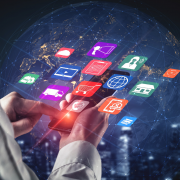HOW BRICK AND MORTAR STORES ARE MAKING A COMEBACK
For years now, traditional retail stores have been under attack. Consumers love the convenience and selection of shopping online, leaving brick-and-mortar stores to be dubbed a dying breed. But smart brick-and-mortar stores are undergoing a major transformation to keep up with the times.
Main Street isn’t what it used to be. Downtown centers of days past were typically lined with coffee shops, cute bookstores, and retail. Today? Many struggle to attract the foot traffic to stay open. This led for retailers searching for new, innovative ways to keep their brick and mortar presence alive.
While legacy companies like Sears are shuttering their doors, a growing number of online-first companies—from Amazon to Rent the Runway—are opening new storefronts and transforming the shopping experience. Here, BARE International highlights three key influences driving the brick and mortar comeback — just in time for the holidays.
AI TECHNOLOGY
The digital landscape has changed since the early days of the Internet. Technology has become such an integral part of our everyday lives, from how we interact with each other to how we buy products and services. To stay competitive in 2020 and beyond, it will be important for retailers to find innovative ways to connect with and engage shoppers as they browse and shop in-store. By integrating AI technology into the physical store, retailers are better able to capitalize on the consumer’s willingness to buy by offering specific and customized information and promotions.
In fact, economists expect that the retail industry, as a whole, will invest more in digitization and personalization this year than any other gone before. This takes the traditional shopping experience from pushing a shopping cart to interacting with digital displays to receive customized messages and coupons. Other ways AI helps retailers include:
- Understanding the customer: Machine learning helps retailers understand their customers and predict future behaviors. From age demographics to personal item preferences.
- Forecasting: We are now seeing retailers using AI and automated machine learning to operate their demand forecasting to understand the actual stock quantity needed today based on the demand from the customers.
- Product supply and development: Machine learning and AI can play a significant role in determining a retailer’s supply and development plans.
GEN Z
In the age of technology, everything seemingly comes fast and easy. For younger generations who were essentially raised to be technologically-savvy and comfortable growing up in a digital world, both Millennials and now members of Generation Z are quite comfortable buying online but surprisingly, large numbers of Generation Z shoppers are taking to retail storefronts to spend their money.
So who are Gen Z? Generation Z is the name given to a segment of the population born between the late 1990’s to the early 2000’s with ages ranging from aRemove term: Customer Experience Cupproximately 10 – 20 years old. And, as a recent study has indicated, these “post-millennials” are dragging their millennial parents out of the house and back into brick-and-mortar stores as a way to tear away from social media time. You heard that right: Despite being the first full generation of digital natives, Gen Z is looking at brick and mortar retailing as a way to, ‘disconnect,’ from the stress of social media while at the same time spending time with friends and family in “retail-therapy”.
(It’s also worth noting, as much as this generation wants an online-break as they shop, free WiFi is a necessity to draw in this demographic so they can document their experiences and clothes try-ons; getting emotionally closer to the online influencers and celebrities they follow).
OMNICHANNEL EXPERIENCE
More and more brands and businesses are thinking of the big picture when it comes to customer experiences. From raising brand awareness to post-purchase customer relationships, the online-to-offline user journey has to be seamless and personal to keep customers enthralled.
Digital advancements aside, the human-to-human connection will never lose its significance. To incorporate all preferences, retailers must deliver a seamless experience across all channels — and the store can be the place to bring it all together. For example, employees equipped with digital devices can display product information on their smartphone and then guide a shopper right to that item in the store. By being connected across channels, shoppers who purchase an item online can have the option of returning it to a brick-and-mortar store — even texting return information and conveniently dropping off the item at a drive-thru window.
While going digital is becoming the synonym of maximizing the efficiency of running a business to make profits, physical stores still retain the key advantages in building and nurturing customer relationships. (Read more on Omnichannel Research Solutions here.)
FINAL THOUGHTS
Throughout the next decade, consumers are poised to redefine how the retail industry attracts and engages with a new age of customers. Realistically, the future of shopping will happen both online and in person.
As more people forgo an exclusively virtual shopping experience and, instead, prefer stores that offer a high level of personalization, retailers can strategically position themselves well to capitalize on this shift of what consumers love the most: options and great experiences.












Leave a Reply
Want to join the discussion?Feel free to contribute!